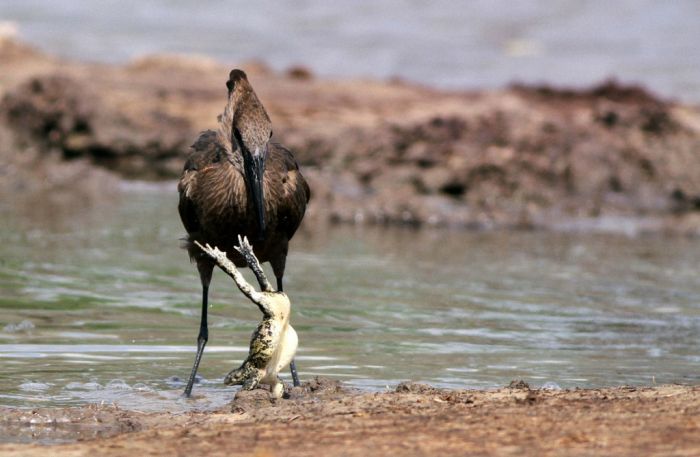Bird With A Dancing Frog
|
The life cycle of a frog starts with an egg. A female generally lays gelatinous egg masses containing thousands of eggs, in water. Each anuran species lays eggs in a distinctive, identifiable manner. An example are the long strings of eggs laid by the common American toad. The eggs are highly vulnerable to predation, so frogs have evolved many techniques to ensure the survival of the next generation. In colder areas the embryo is black to absorb more heat from the sun, which speeds up the development. Most commonly, this involves synchronous reproduction. Many individuals will breed at the same time, overwhelming the actions of predators; the majority of the offspring will still die due to predation, but there is a greater chance some will survive. Another way in which some species avoid the predators and pathogens eggs are exposed to in ponds is to lay eggs on leaves above the pond, with a gelatinous coating designed to retain moisture. In these species the tadpoles drop into the water upon hatching. The eggs of some species laid out of water can detect vibrations of nearby predatory wasps or snakes, and will hatch early to avoid being eaten. Some species, such as the Cane Toad (Bufo marinus), lay poisonous eggs to minimise predation. While the length of the egg stage depends on the species and environmental conditions, aquatic eggs generally hatch within one week. Other species go through their whole larval phase inside the eggs or the mother, or they have direct development. Unlike salamanders and newts, frogs and toads never become sexually mature while still in their larval stage.
Eggs hatch and continue life as tadpoles (occasionally known as polliwogs), which typically have oval bodies and long, vertically flattened tails. At least one species (Nannophrys ceylonensis) has tadpoles that are semi-terrestrial and live among wet rocks, but as a general rule, free living larvae are fully aquatic. They lack eyelids and have a cartilaginous skeleton, a lateral line system, gills for respiration (external gills at first, internal gills later) and tails with dorsal and ventral folds of skin for swimming. From pretty early onward they develop a gill pouch that covers the gills and the front legs and also the lungs are developed in an early stage as an accessory breathing organ. Some species which go through the metamorphosis inside the egg and hatch to small frogs never develop gills, instead there are specialised areas of skin that takes care of the respiration. Tadpoles also lack true teeth, but the jaws in most species usually have two elongate, parallel rows of small keratinized structures called keradonts in the upper jaw while the lower jaw has three rows of keradonts, surrounded by a horny beak, but the number of rows can be lower or absent, or much higher. Tadpoles are typically herbivorous, feeding mostly on algae, including diatoms filtered from the water through the gills. Some species are carnivorous at the tadpole stage, eating insects, smaller tadpoles, and fish. Cannibalism has been observed among tadpoles. Early developers who gain legs may be eaten by the others, so the late bloomers survive longer. This has been observed in England in the species Rana temporaria (common frog).
Tadpoles are highly vulnerable to predation by fish, newts, predatory diving beetles and birds such as kingfishers. Poisonous tadpoles are present in many species, such as Cane Toads. The tadpole stage may be as short as a week, or tadpoles may overwinter and metamorphose the following year in some species, such as the midwife toad (Alytes obstetricans) and the common spadefoot (Pelobates fuscus). In the Pipidae, with the exception for Hymenochirus, the tadpoles have paired anterior barbels which make them resemble small catfish.
With the exception of the base of the tail, where a few vertebral structures develop to give rise to the urostyle later in life, the tail lacks the completely solid, segmental, skeletal elements of cartilage or bony tissue that are so typical for other vertebrates, although it does contain a notochord
|
|









